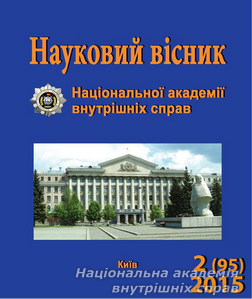The psychological nature of the subjective side of robbery
Keywords:
public danger, the subjective side, intent, fault, rubbery, criminal
Abstract
In the article the concept of public danger of robbery. Indicated that public danger robber person – is a socio-psychological state, not the legal status of the offender as a condition, not a result of the crime. Taking into account the specifics of robbery, the most important characteristic is its subjective side, ie mental processes taking place in the consciousness of the subject, describing it i will appear in the criminal act and attitude of a person to acts committed by it. The concept and basic features subjectively robbery. Established that the blame is conscious and willful attitude of a person not to all the circumstances that characterize the act but only to those that are signs of the crime and characterize its object and objective way, and sometimes the subject. Established that the property in the commission of violent criminal attacks has not only deliberately relatively to commit robbery, but with the intent to use violence as a means of taking possession of the victim of his property. in determining intent should consider factors both objective and subjective. Since the robbery – a crime of formal and truncated composition, objective harm can not be caused, but the guilty person is liable because its actions pose a real danger to society. So thorough and exhaustive study method of committing the crime together with other circumstances of the case to set the actual content of the subject robbery intent, based on damage or injury of the victim, and thereby avoid errors in classifying the act.Downloads
Download data is not yet available.
Abstract views: 73 PDF Downloads: 250
How to Cite
[1]
Kazmirenko, V. 1. The psychological nature of the subjective side of robbery. Scientific Herald of the National Academy of Internal Affairs. 95, 2 (1), 61-67.
Issue
Section
Combating crimes: theory and practice
- Authors reserve the right to authorship of their own work and transfer to the magazine the right of the first publication of this work under the terms of the Creative Commons Attribution License, which allows other persons to freely distribute published work with mandatory reference to authors of the original work and the first publication of an article in this magazine.
- Authors have the right to enter into separate additional agreements on non-exclusive dissemination of the work in the form in which it was published in the journal (for example, to post an article in the institution's repository or to publish as part of a monograph), provided that the link to the first publication of the work in this journal is maintained.
- The journal's policy allows and encourages the posting of articles by authors on the Internet (for example, in electronic storehouses of institutions or on personal websites), both before the submission of this manuscript to the editorial office and during its editorial processing, as this contributes to the creation of a productive scientific discussion and positively affects the efficiency and dynamics of citing the published work.




